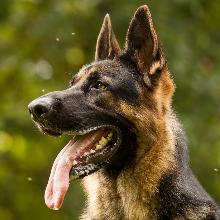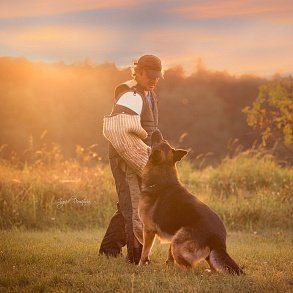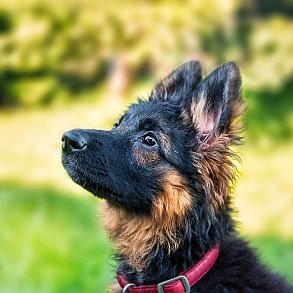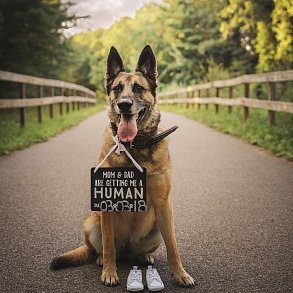German Shepherd

The German Shepherd has been living side by side with man since time immemorial. Today it is one of the most popular and recognizable dog breeds on the planet.
- Brief information
- Highlights
- Breed characteristics
- History of the German Shepherd breed
- Appearance of a German Shepherd
- Character of the German Shepherd
- Education and training
- Care and maintenance
- Health and diseases of the German Shepherd
- How to choose a puppy
- How much does a German Shepherd dog cost
Brief information
- Breed name: German Shepherd
- Country of Origin: Germany
- The time of the birth of the breed: the end of the XIX century
- Weight: males 30-40 kg, females 22-32 kg
- Height (height at the withers): males 60-65 cm, females 55-60 cm
- Life expectancy: 10-13 years
Highlights
- German Shepherds can be both service dogs performing security or search functions, and companions for families.
- Loyal and compliant pets unquestioningly recognize the authority of the owner.
- German Shepherds are among the three smartest dog breeds (along with border collies and poodles).
- They need human society and physical activity.
- Get along well with children of all ages.
- Are able to live not only indoors, but also in an aviary.
- The average life expectancy of a German Shepherd is 9-13 years, after 7 years strict health monitoring is necessary.
German Shepherd - a regular at the top of the rankings of the smartest, most loyal, most trained pets. The noble "faces" of these dogs often flash in news stories, on newspaper pages and even in the title roles of various TV shows. But the main vocation of the Germans is not an acting career, but policing. They serve in the police, border and customs units, help in search and rescue operations. And at home, representatives of this breed protect the peace and property of the owners, give their owners a lot of positive emotions.
Breed characteristics
History of the German Shepherd breed
To track the history of some breeds (for example, doberman and airedale terrier , which "come from" the XIX century, or the Old English bulldog bred in 1970), it is enough to refer to official documents and eyewitness accounts. With German Shepherds, the situation is completely different. According to researchers, the beginning of the chain of their immediate ancestors should be sought in the depths of centuries.
Archaeological finds indicate that back in the IV millennium BC, animals lived on the territory of modern Czech Republic, Poland and Germany, the skeleton of which has a lot of features similar to sheepdogs. These were the consequences of the evolution of wild individuals who chose to live near the sites of ancient tribes and became dependent on humans. It is assumed that some kind of primitive selection was already carried out, during which the largest and most obedient puppies were selected.
The now defunct small Indian wolf was increasingly moving away from its "free" relatives and gradually turned into the so-called Bronze Age dogs. Over time, people's needs have changed. Not only farmers, but also cattle breeders were more or less tied to a certain area. This means that the four-legged satellites have new functions. In the Middle Ages, Hofwarts were bred throughout Europe. This German word translates as "guardian of the yard", but the dogs were engaged not only in the protection of real estate.
Domesticated cattle needed reliable protection from ruthless predators and hunters of other people's goods. Given the growing number of herds and flocks, it was simply impossible to cope with such a task by the forces of shepherds. That's when the yard dogs came to the rescue. Of course, not everyone was suitable for such work, but only the most intelligent and hardy. They began to be selected and trained in a special way. And everything special is valuable, because already in the VII century, according to the laws of the ancient Germanic tribe of the Alemans, a severe punishment awaited the culprit for the murder of a shepherd dog.
Of course, the animals of the early Middle Ages, and much later epochs, outwardly little resembled modern representatives of the breed. Fundamentally important for the so-called primitive German Shepherds were not the shape of the head and the setting of the tail, but the corresponding intelligence, rather large dimensions and a "psychological portrait". The fact is that the way of life of shepherds assumed prolonged isolation, during the grazing season the animals actually came into contact exclusively with "their" man and had to not only obey implicitly, but also become good companions to him.
By the XVIII century, the situation had changed somewhat. Two regional types of German shepherd dogs took shape at once – semi-long-haired Thuringian pale-gray color with a curling tail and long-haired Württemberg black or red color with semi-erect ears. They also differed in character: the former were called active animals, prone to loud and frequent barking, and the latter could boast of calmness and endurance. In the name of a common cause, breeders from the central and southwestern lands decided to join forces.
The result of the hard work of enthusiasts was presented to the general public only at the end of the XIX century. Baron von Knigge brought two of his pets, Greif and Cuirass, to the Hanover Dog Show in 1882, and later the owners of the Gannau kennel warmed up interest in the new breed, who showed the public an impressive pair – large and powerfully built Pollux and Prima. It was thanks to them that almost two dozen champions and winners of exhibitions of the following decades were born.
In 1891, the creation of the first society of German Shepherd lovers was announced. The organization "Filax" existed for a very short time, but managed to approve the breed standard. The next landmark event should be considered an exhibition in the small town of Karlsruhe on the German-French border. The event would have remained unnoticed by anyone if it had not been possible to see an outstanding representative of the old-format type. And not among the participants!
Hector von Lirkenhein was just entertaining visitors with a demonstration of herding skills. By a happy coincidence, a retired military man Max von Stefanitz and his friend Arthur Meyer passed by, who devoted their free time to breeding German Shepherds and immediately noticed the perfect external data of the dog, which was not inferior to his working qualities. The owner, however, did not want to part with his pet just like that, it took several weeks to negotiate.
Having got the perfect "German", von Stefanitz entered him as the first number in the book of breeding breeding under a new name – Horand von Grafrat. At the same time, large-scale searches for relatives of the type of bitches begin. The efforts were rewarded, a sufficient number of worthy successors of the breed were born in the litters received from Horand. Most modern purebred lines are somehow connected with his son Hector von Schwaben, grandchildren Pilot, Beowulf, Heinz von Starkenburg. The breeding of today's recognizable black and yellow dogs began with Hettel von Uckermark, the son of Roland von Starkenburg. Another outstanding representative of the breed is called Clodo von Boxberg, who became the winner of the international exhibition in 1925 and laid the foundation for new breeding lines.
Max von Stefanitz died in 1936. There is an opinion that indirectly this was facilitated by the attacks of members of the National Socialist Party, who did not want to popularize German Shepherds outside Germany and even threatened the enthusiast with imprisonment in a concentration camp. During the Second World War, many nurseries were destroyed, many animals died, and no one cared about the purity of the blood of the remaining ones. But several valuable representatives of the breed managed to be preserved, and in peacetime the followers of von Stefanitz continued to work on the development of the breed. Exhibitions resumed in 1946, and five years later a new hero appeared at one of them – champion Rolf von Osnabrücker, the founder of modern "high breeding" lines.
Back in April 1899, the German Shepherd Owners' Union was established. The activities of von Stefanitz, Meyer and other leaders were mainly aimed at maintaining blood purity, which would be confirmed by relevant documents, encouraging outstanding breeders and developing the working qualities of the breed. The organization still exists, and in May 1968 an international association was founded, which today is known as the World Union of German Shepherd Associations and unites 89 national unions from 82 countries.
Video: German Shepherd
Appearance of a German Shepherd
German Shepherds are medium-sized. The height of the male at the withers is 60-65 cm, the weight is 30-40 kg, bitches are 5 cm lower and 8 kg lighter. The proportional ratio of height and weight is important. The dog is slightly elongated, strong and muscular, built firmly, but the backbone is not rough.
Head
The length of the head is 40% of the height of the dog at the withers. The shape is wedge-shaped, but not too elongated, moderately wide between the ears. The forehead is slightly convex. The ratio of the cranial and facial parts is 1:1. The transition between them is expressed smoothly.
Neck
The German Shepherd has a neck length approximately equal to the length of the head. Strong and muscular, very mobile.
Eyes
Oval shape, slightly obliquely spaced, not convex, medium size. The color is dark.
Nose
Classic shape, without a clear dividing line. The nose lobe is black.
Teeth and jaws
The upper and lower jaws of the German Shepherd are well developed. The teeth are strong, the dental formula is complete. The lips fit snugly to the jaws. The bite is scissor-shaped.
Ears
The ears of the German Shepherd are large, erect, triangular in shape, directed parallel. The auricles are open forward. Ear cartilages are elastic, without creases and bends.
Torso
The thorax is long, wide and deep. The line of the back goes down from the withers to the croup. The withers are strong, the back is broad and strong, the croup is sloping, with an imperceptible transition to the base of the tail.
Tail
The tail of German Shepherds is relatively long, slightly bent, lowered down in the usual position. Fluffy, and the hair is longer on the lower part of the tail.
Limbs
The front legs are straight, parallel when viewed from the front. Strong and muscular. The shoulder blades and humerus bones have the same length, connect at right angles. The hind legs are slightly set aside, when viewed from behind straight, parallel. The thigh and lower leg are of the same length, connected at an angle of 120 °. Strong and muscular. The front paws are rounded, the toes are arched. The hind legs are compact, the toes with a slight arch.
Wool
Double, with thick, straight, coarse outer hair and thick undercoat.
Color
Black with reddish-brown, brown, yellow to light gray markings. Solid black or solid gray. Zonal-gray sheepdogs demonstrate a black cheprak and mask.
Photo of an adult German Shepherd
Character of the German Shepherd
All owners of German Shepherds without exception call them loyal, intelligent, calm and obedient animals. The key to a beautiful character is a stable psyche of the animal and proper upbringing.
The high intelligence of the Germans is not accompanied by a desire for independence and stubbornness, they easily and with pleasure master new games, teams, territories. Dogs do not like loneliness, but patiently wait for the return of the owner. For a good mood and normal well-being, they are in dire need of human society, including long walks and outdoor games.
Innate protective instincts remain one of the important features of the German Shepherd, so they are wary of strangers in the dwelling and even during a walk, although they never show aggression without a reason. Loyalty to the owner and family of these pets is elevated to the degree of absolute, they are ready to sacrifice themselves, protecting the household from danger, and assess the degree of danger instantly and adequately.
German Shepherds love children and enjoy playing with them. However, it is not recommended to leave the kids alone with the dog – at least because of the difference in size and weight. The shepherd is tolerant of other animals in the house, friendly relations are possible if they grow up together.
Education and training
As mentioned above, German Shepherds are smart and easily trained animals. But the upbringing of a large dog should never be allowed to take its course. From the first months of life, in the form of interesting games and tasks, the performance of which is accompanied by the receipt of treats, the puppy gets an idea of acceptable norms of behavior and important commands.
The owner should demonstrate his authority without resorting to shouting and, moreover, physical force. If it seems to you that there are significant deviations in the behavior of the puppy that you cannot cope with yourself, be sure to seek help from a specialist dog handler.
Of course, not every German Shepherd becomes a service dog and guards order in special units. But even a pet needs to understand and respond adequately to the basic commands: "To me!", "Place!", "Not allowed!", "Nearby!", "Sit!", "Lie down!", "Walk!", "Aport!".
When the backbone of the puppy gets strong enough, you can start overcoming obstacles (be sure to take into account the height of the height and the capabilities of the pet). The fundamental point is to teach the dog to walk on a leash, and from six months – in a muzzle. It is better to do this gradually and do not forget about the delicious encouragement for obedience.
It is important to remember that German Shepherds reach psychological maturity quite late, by the age of three. A young dog, whose dimensions are quite consistent with the breed standard, internally remains vulnerable, requiring care and approval by a puppy.
Care and maintenance
Features of the structure of wool allow the German Shepherd to live both indoors and in the yard. In the second case, a spacious aviary with a insulated booth is needed. In addition, it is desirable to at least partially protect the aviary from precipitation and wind.
Immediately after the appearance of the dog in the house, determine for her her own place, where the bedding or mattress, toys will lie. There should be no direct heat sources and drafts in the immediate vicinity of it. Natural materials that do not need complicated cleaning are preferred for the couch. A sufficient number of toys will protect furniture and shoes from sharp teeth.
The main aspect of the proper maintenance of any dog is a balanced diet that will ensure normal development and good health for life. The easiest way to guarantee a full-fledged diet can be ready–made premium and super-premium feeds for the appropriate age category, and for adult animals - taking into account special needs. With a "natural" diet, it is important to observe the ratio of protein products and fiber recommended by veterinarians. And, of course, it is impossible to feed the shepherd with scraps from the human table, because its digestive system is not ready to work with fatty, fried, salty foods and spices. Fresh water should be available at all times.
As it gets dirty (but not too often), it is necessary to bathe the dog in warm water with special shampoos. Combing is carried out once or twice a week, during the period of seasonal molting, the procedure has to be performed more often. The condition of the ears, eyes, mouth, nasal passages should be regularly monitored.
It is recommended to visit a veterinarian for a preventive examination at least 2-3 times a year.
Health and diseases of the German Shepherd
The average life expectancy of a German Shepherd is 9-13 years.
Difficulties in the formation of the breed and forced inbreeding led to the emergence of a number of serious diseases. Some manifest themselves even in puppyhood: growth hormone deficiency, diabetes, leukemia, eosinophilic panostitis (intermittent lameness), intestinal intussusception, pyoderma (purulent skin lesions).
Allergies, hip dysplasia, intervertebral disc diseases, arthritis, corneal dystrophy, epilepsy, cataracts, pancreatic insufficiency, tricuspid or mitral heart valve dysplasia, aortic stenosis (narrowing of the vessel opening), exudative pericarditis (inflammation of the outer membranes of the heart), cancer, paralysis of the hind limbs may occur later.
Under the influence of external factors, ear and eye infections, dermatitis, inversion of the intestines, bloating of the stomach and others may begin.
At the first signs of ill health, it is necessary to contact a veterinary clinic, where they will be able to make the correct diagnosis and begin treatment. In addition, it is important to regularly appear at the doctor for a routine examination – especially for puppies during the period of active growth and dogs older than 7 years.
How to choose a puppy
The above-mentioned features of appearance and character relate to purebred German Shepherds, that is, to those whose pedigree has been confirmed by official documents for several generations. Half-breeds, of course, can be wonderful and devoted pets, but still they are completely different dogs.
Future owners who are interested in a particular breed should look for a puppy only from proven breeders and in kennels with an excellent reputation. So you can be sure of the absence of genetic diseases and the "branded" stability of the psyche, which is so important for a large pet.
Responsible breeders do not give customers puppies whose age is less than 8-10 weeks. By this time, the little German is already confidently standing on his paws, responding to his own name and ready to start training.
If the dog is not purchased for breeding and participation in exhibitions, the main selection criteria are its health and friendliness. Indicators of the first are considered to be a good appetite, playfulness, clean eyes, nose and ears, shiny coat, elastic belly without signs of bloating. A young German Shepherd should not be afraid of calmly behaving people or react aggressively to attempts to approach.
It is also better to "get to know" the parents in order to have an idea about the heredity of the future pet, and look at the conditions of keeping a mother with babies. Cleanliness, sufficient space, high–quality food and the availability of toys, timely vaccination are undoubted evidence in favor of the breeder.
Photos of German Shepherd puppies
How much does a German Shepherd dog cost
Potential winners of exhibitions with impeccable compliance with breed standards and "champion" pedigree will not cost less than a thousand dollars. They are usually sold at the age of 5-6 months, or even older – when the external data has already been formed and even has experience of participating in junior "shows".
Purebred German Shepherd puppies that do not claim international recognition due to certain formal shortcomings, but can become excellent service and security or family dogs, sold in kennels at a price from 300 to 900 dollars.
Dogs without pedigree are significantly cheaper, but in this case no one guarantees you either external or psychological compliance with the ideas of a real German Shepherd.


